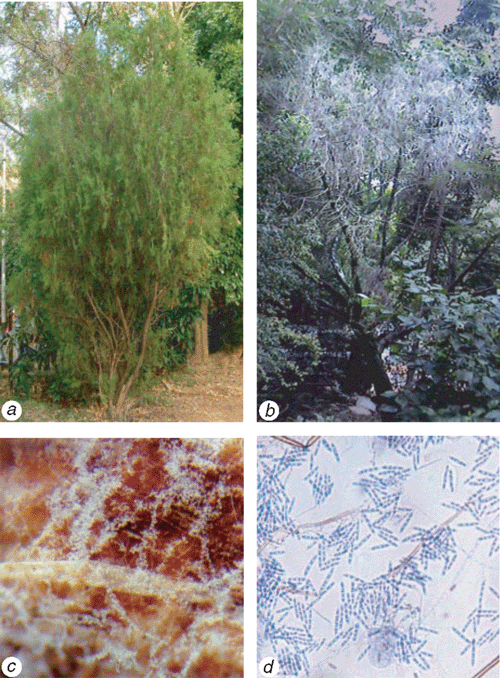First Report of Fusarium oxysporum causing Fusarium wilt on Thuja orientalis in India
V. B. Raghavendra A , N. Sunayana A , M. Govindappa B , A. J. Mahadesh Prasad C , S. T. Girisha D and S. Lokesh A EA Department of Studies in Applied Botany, Seed Pathology and Biotechnology, University of Mysore, Manasagangotri, Mysore, Karnataka 570 006, India.
B Institute of Plant Genomics and Biotechnology, Borlaug Center for Southern Crop Improvement, Texas A&M University, College Station, TX 88743-2123, USA.
C Department of Studies in Biochemistry, University of Mysore, Manasagangotri, Mysore, Karnataka 570 006, India.
D Yuvaraja’s Degree Science College, Mysore, Karnataka 570 006, India.
E Corresponding author. Email: viragh_79@yahoo.com
Australasian Plant Disease Notes 2(1) 87-88 https://doi.org/10.1071/DN07035
Submitted: 15 January 2007 Accepted: 30 May 2007 Published: 14 June 2007
Abstract
Fusarium oxysporum was recorded for the first time on Thuja orientalis trees in the Mysore University campus during 2006–07. Thuja trees are important because of their antifungal and antibacterial properties. The fungus was isolated from the wilted plant parts and subsequent reinoculation of the same to healthy plants confirmed the pathogen as the causal organism.
Thuja orientalis (Cupressaceae) is an important medicinal tree found in tropical and subtropical countries. It is an evergreen tree, rich in borneol, bornyl acetate, thujone, camphor and sesquiterpenes (Dan and Nhu 1989). The leaves are used for their antibacterial, antipyretic, antitussive, astringent, diuretic, haemostatic and refrigerant effects, and are used to treat bronchitis, asthma, skin infections, mumps, bacterial dysentery and arthritic pain (Brown 1995).
During a plant survey made in the Mysore University campus, Mysore, Karnataka, India, a previously unrecorded leaf wilt of Thuja trees was noticed. Affected plants exhibited symptoms of chlorosis, wilting and death (Fig. 1a, b). Leaves on wilted plants showed gradual yellowing, apical necrosis and premature defoliation. At advanced stages of the disease, irregular, brown, necrotic areas occurred on the leaves. The necrotic lesions extended to the entire leaf, occasionally expanding and coalesced to form large necrotic lesions that turned the entire leaf brown. Other symptoms included stunting and black streaking on the stems. For the purpose of identifying the causal organism, leaves were gently washed and incubated on wet blotters for a period of 1 week. Fungal colonies were isolated and identified as Fusarium oxysporum on the basis of morphological and cultural characteristics according to the description in Booth (1977) (Fig. 1c, d). Pathogenicity tests were carried out on 6-month-old healthy plants of T. orientalis. Koch’s postulates were completed for two isolates by mist spraying 10 healthy plants with a conidial suspension (2 × 105 conidia/mL). Inoculated Thuja plants were covered with plastic bags to increase humidity to above 70% at 25 ± 2°C in the greenhouse. After a period of 1 month, the inoculated plants showed typical symptoms, i.e. the leaves became chlorotic and the plants withered and died. No symptoms were observed on control plants, which were sprayed with distilled water. The fungus was successfully reisolated from the symptomatic plants, fulfilling Koch’s postulates.

|
There are many reports available on the antifungal and antibacterial properties of the Thuja extracts. But to date no reports are available on the occurrence of wilt of T. orientalis due to F. oxysporum.


